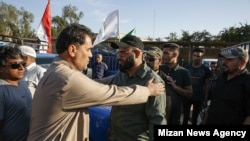A convoy of 50 vehicles has carried Iraqi Al-Nojaba and Hashd al-Sha'bi militias into Iran's flood-hit western provinces, reported IRGC-linked Tasnim News agency on Sunday April 14.
Meanwhile the IRGC commander in Ilam province says a large convoy of Iraqi militia have arrived in the province. The commander, Jamal Shakarami, has characterized the Iraqi militia as an ally of the Islamic Republic.
Iranians on social media have been complaining why a country that has two armies, namely the IRGC and the conventional army, needs help from foreign militias for flood relief efforts.
According to Shakarami, a convoy of Al-Nojaba forces have arrived in Dehloran in Khuzestan Province.
Earlier, Iraj Masjedi, Iran's ambassador in Baghdad told Iranian news agencies on Saturday that Hashd al-Sha'bi forces have been deployed to Khuzestan to help with flood relief. Masjedi said hundreds of Iraqi militia, including 200 on Friday, have arrived in Iran to help the flood-hit people in Khuzestan and Lorestan provinces in western Iran.
The Al-Nojaba movement has announced that its leader Haj Nasr al-Shemri is accompanying the units deployed in Khuzestan.
A Twitter user has published the arrival of one Iraqi convoy, saying "The Fascist Hasd al-Sha'bi entered Iran..."
According to hardliner daily newspaper Kayhan, which is close to Iranian Supreme Leader Ali Khamenei's office, Hashd al-Sha'bi, Al-Nojaba and Afghan Fatemyoun militia have arrived in Khuzestan at the invitation of IRGC's Qods Force Commander Qassem Soleimani.
In the meantime there has been strong protests on social media against foreign militia's presence in Iran. Some have characterized the militia as occupying forces. Others maintain that they are in Iran to suppress possible protests.
The hashtag HashdalSha'bi in Persian is making the rounds on Twitter as many users say this is a sign how afraid the Islamic Republic is of rebellion by the people and some compare Iran's Supreme Leader to former Libyan strongman Qaddafi in his last days.
The invitation by Soleimani follows a statement by Tehran Revolutionary Court Chairman Mousa Ghazanfarabadi, who said in Mid-March "If we do not help the Islamic Revolution, Iraqi Hashd al-Sha'bi, Afghan Fatemyoun, Pakistani Zaynabioun and Yemeni Houthis will. These are Iran-backed militia groups in the region who have been fighting proxy wars in Iraq, Syria and Yemen on Tehran's behalf.
Meanwhile, Prince Reza Pahlavi, the heir to Shah Mohammad Reza Pahlavi, who inspires part of the Iranian opposition, issued a statement saying that the Iraqi militia were in Iran to suppress dissent, otherwise the Iranian army is equipped with the machinery to cope with the flood and to serve the flood-hit people.
Still others such as twitter user Parhami have issued explicit threats against the militia, telling them to leave at once.
While some defend the arrival of Iraqi militias, others say that if the neighboring country wanted to officially help Iran they would have sent their relief organizations, not paramilitaries.
Some videos on social media show "IRGC units confronting the people who resist against evacuating their homes." However, IRGC public relations chief Ramezan Sharif says IRGC forces try to convince people in flood hit areas to move to safe areas.
A day after the denial, reports say that one such person, Aboud Jalizi, a farmer in Khuzestan has been killed following a confrontation with IRGC forces who shot him last week.
Other reports say others, including Khalaf Marvani has been arrested and taken away after protesting the destruction of a dike by the IRGC.
In one video, the governor-general of Khuzestan calls an elderly citizen "rude and part of the opposition" after the man asks why officials help Syria but fail to help the flood-hit people.
The latest reports on the flood indicate heavy rainfall in the southeast, while the situation in other parts of Iran, particularly Khuzestan, Lorestan and Golestan provinces remain critical. And while the public does not seem to be happy with what the government and military forces have done so far to cope with the crisis, four cabinet ministers briefed the Iranian Parliament on Sunday on relief efforts.
In the latest development Khamenei has agreed to allocate funds to flood relief out of the country's foreign currency reserve.



